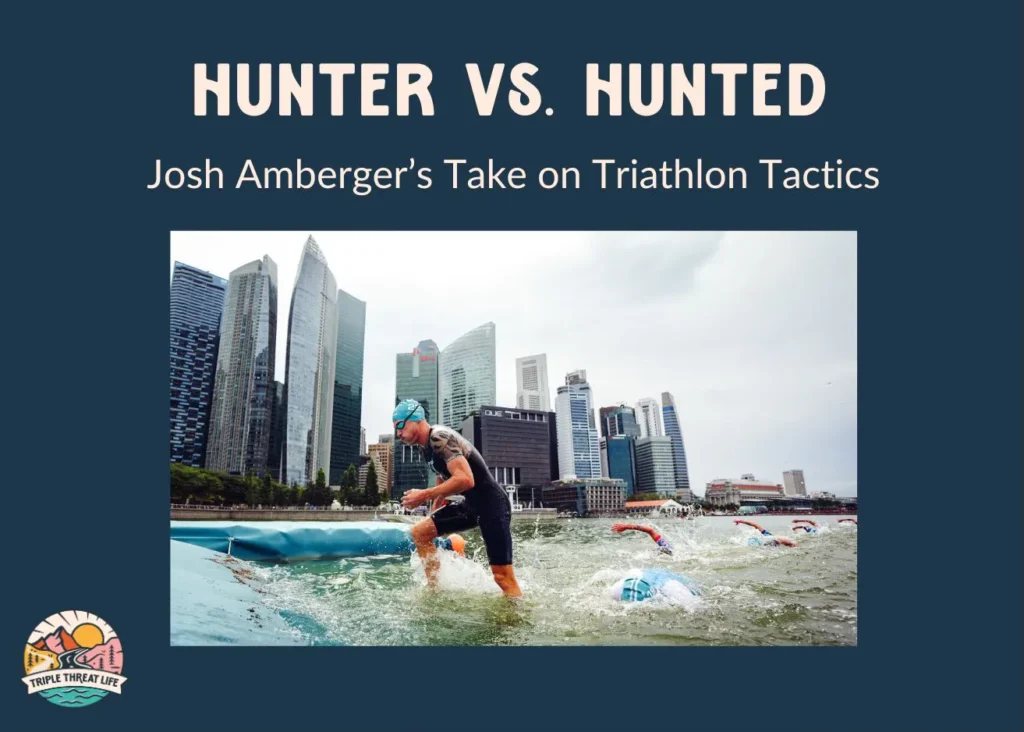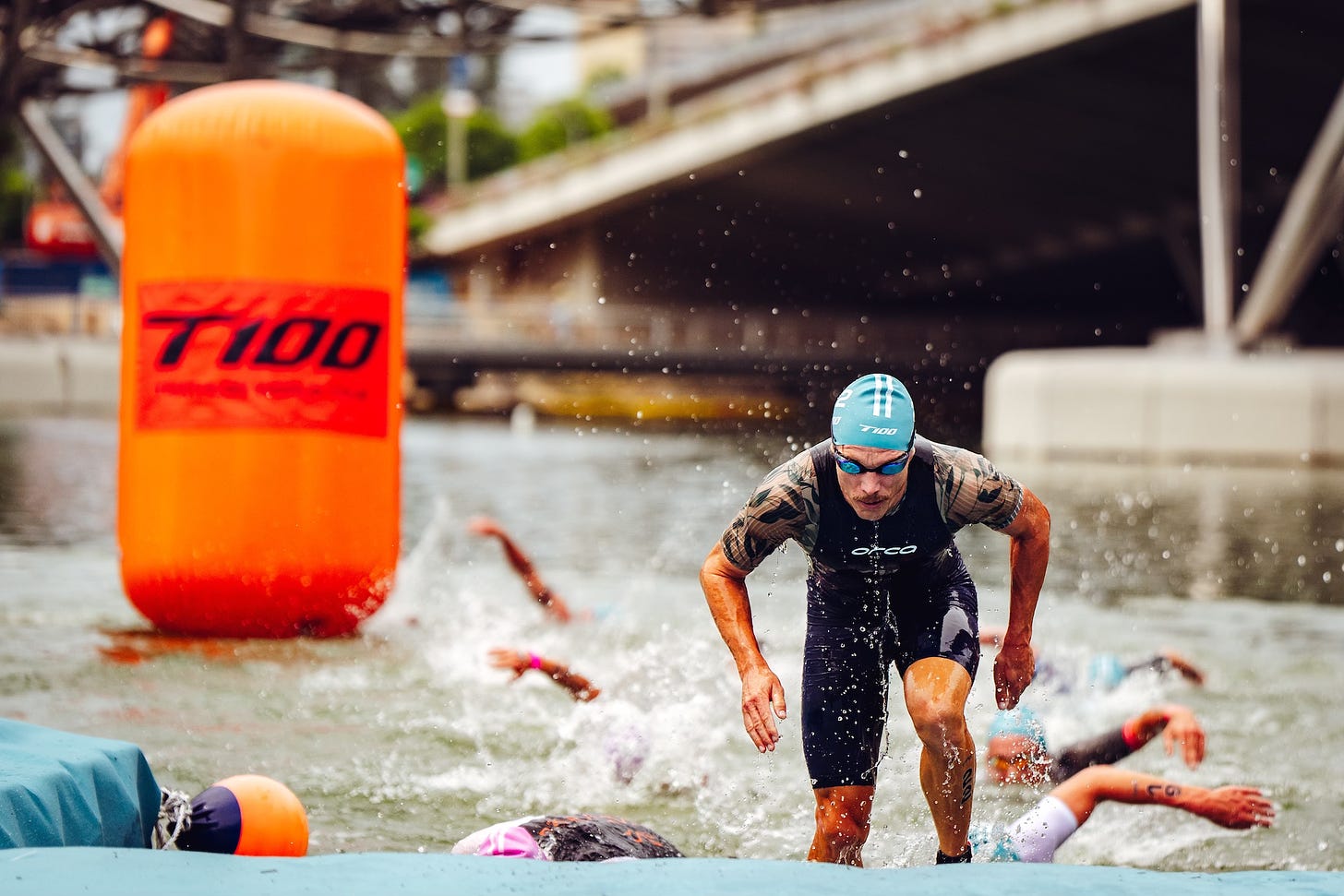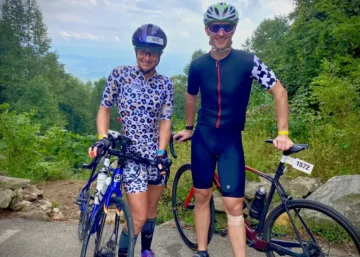
When it comes to racing (especially triathlon) there’s a unique dichotomy that exists between the hunter and the hunted.
The hunter is the athlete in pursuit. He’s the chaser.
While the goal is to be the first across the finish line, some athletes prefer being in this position during a race for a few reasons. First, there’s less pressure because you don’t have to set the pace. Second, you can adjust your strategy based on the moves that the leader makes.
The hunted is the athlete at the front of the race. He’s the leader, and his sole objective is to maintain that lead all the way to the finish.
Being in the lead can provide a psychological advantage, which instills confidence. In this position, an athlete can dictate the pace that everyone else must follow.
But it also comes with a downside. You’re being chased, and it can be hard to keep track of what athletes are doing behind you.
How often have you heard phrases like this?
“I let her go, because I knew I would catch her if I executed my own race plan.”
“His finish is strong, so I had to push the pace from the start and make him uncomfortable.”
These statements demonstrate the importance of knowing your own strengths and weaknesses, as well as those of your competitors. Racing as the hunter or the huntedcan be a purposeful choice, but sometimes it happens as a result of how a race plays out on a particular day.
“The hunter must become the hunted. He must accept that there will always be someone faster, stronger, or smarter who is waiting for him to make a mistake.”- John Preston in Equilibrium
I stumbled across a fascinating study related to this topic. Researchers analyzed the performance of 171 elite, male triathletes at 14 elite, Olympic distance triathlons over 3 consecutive years.
Variability in race conditions, wetsuit vs non wetsuit, and course terrain make it difficult to isolate and control all factors that influence triathlon performance. However, there’s an aspect of racing that athletes can control and use to their advantage.
*How you navigate race dynamics
In triathlon, there are two crucial points when race dynamics develop.
First is the swim. Strong swimmers often push the pace from the gun in an attempt to come out of the water in the lead. The goal is to create a gap between themselves and any strong cyclists or runners in the field.
Second is the bike. Strong cyclists may form a group and try to increase their lead on the strong runners. The goal is to use their cycling prowess to get a head start for the run where they know there’s a high likelihood of being caught.
According to the study, “Despite the psychological optimism some athletes might experience from a fast start, and positioning themselves ahead of other competitors early on, the final run result might be hindered if they cannot sustain that pace.”
This has to do with knowing your limits, maximizing your strengths, and minimizing your weaknesses.
A few key insights:
- A positive pacing strategy, where an athlete’s speed decreases over the duration of the race, was utilized by almost all triathletes in the study. (likely unintentional, but as a result of intense effort)
- The top runners implemented a less variable (more consistent) run pace than the rest of the field. The top 8 best run times in each race were achieved with a more even-paced run strategy.
- Over 80% of the overall race outcome was explained by run performance.
So what do we know?
It’s obvious that the run is crucial in any distance of triathlon. *But the fastest runners don’t always win the race. Why?
Run performance is greatly affected by how an athlete executes the swim and the bike.
Physiological differences can also factor into an athlete’s pacing plan.
For example, an athlete with a large anaerobic engine might benefit from a fast start or mid-race surge to break away from the competition. On the other hand, a triathlete with a fast run might benefit from an even-paced approach to ensure there’s enough left in the tank to let their best discipline shine.

Q&A with Professional Triathlete Josh Amberger
I’ve only been in the lead of a race once. The experience was utterly terrifying.
For most of the race, I ran like a scared, little rabbit, because I had no idea how far back my competitors were or how long I could hold them off. Thankfully, on that day, it ended in my favor. Still, I’d much rather chase the carrot than be the carrot.
When thinking about who I should interview for this piece, I wanted someone with a bit more experience in this area.
Enter professional triathlete Josh Amberger.
Josh is a character. And I mean this in the best possible way.
He’s hilariously irreverent, and unapologetically himself, 100% of the time.
For some proof, here’s the highlight quote on his website.
“My name is Josh Amberger & my passions include; death metal, black metal, doom metal, films about war, death & suffering, quotes from fictional kings before age ending battles, doodling instruments of torture while I chat to my friends on the telephone, & sometimes I compete in triathlon.”
But don’t be mistaken by his witty eccentricity, Josh is a competitor.
Triathlon has been his passion, hobby, and job since he was 18 years old. During his first year in long distance triathlon, he won his first Ironman. During his first year racing at Kona in 2017, he came out of the water with a two minute lead and spent a few blissful hours at the front of a World Championship race.
Based out of Brisbane, Australia, Josh is a dynamic swimmer and has found himself at the front of a race a time or two.
“I would probably say, when I was younger and earlier my career, I definitely used to race from the front a lot,” he says. “That was by virtue of coming out of the water with a 2-3 minute lead. I’m not going to sit there and have a cup of coffee in transition. I’m going to go for it.”
Josh says that running has historically been his “weakest” of the three disciplines, so pushing the pace in the swim and racing off the front is how he won races.
He describes this ability to race as the leader (hunted) as both “a blessing and a curse.”
“The number of times I’ve gotten second from being caught in the last 1-2km is ridiculous… That used to affect me more than it probably should have,” he admits.
“Being at the front was great, until there was a situation that was out of my control. When I was younger, it used to be about being in control of the race, and I used to really thrive in those conditions. But as the sport has become more competitive in the last ten years, that doesn’t happen anymore. I might lead out the swim and then I’m never at the front.”
“I’ve had to adjust my strategy, along with my expectation and mindset, to realize that I’m not a frontrunner for anywhere as long as I used to be.”
“In the hunt, the distinction between predator and prey is blurred; both are bound by the same rules of survival, each one a heartbeat away from becoming the other.”- Charles Darwin
Having an accurate assessment of his own abilities, as well as the emotional maturity to be able to adjust expectations, is the mark of a truly self-aware athlete.
“For some races, I go in with the expectation that I’ve got a good chance of winning,” he says. “But if it’s a World Championship with 50 of the best men in the world, I know that’s not going to be a likely scenario on that day.”
“I feel as I’ve aged and experienced, I can be much more malleable with my expectations of how a race is going to unfold. It doesn’t affect me as much as it used to if things don’t go to plan.”
While many age-groupers can’t relate to being at the front of a race, we certainly understand what it feels like when things don’t go to plan. Having the ability to adjust, adapt, and make changes on the fly ultimately determines your success in this sport.
But for a professional triathlete, the desire to execute a race plan must be balanced alongside the need to respond to race dynamics.
Stick to the plan too closely and you might not be able to make up the ground needed to reach the race leader. Go off the rails too much and you might blow up and limp to the finish.
Where elite athletes have an advantage over us regular humans is they know their limits, having tested them daily in training, and they excel at pacing. But this is a skill we can learn.
Josh credits his ability as a pace master to his background in swimming. With nothing other than the clock to provide feedback, he had to rely solely on his rate of perceived exertion.
“I’m an athlete who’s very aware of my limits. I think part of growing up as a swimmer is you become very attuned to your effort level,” he says. “As an athlete, I’ve been able to use that skill very well. So if there’s an attack going, yes I might have to respond to that attack if I want to win the race, but I’m very good in the moment knowing whether it’s a realistic effort if I want to get to the finish line in good shape.”
Josh has coined this skill “athletic intellect.”
He recalls a situation that took place at T100 Singapore earlier this year when his ability to know his limits, and stay within them, ultimately helped him achieve an excellent finish.
“There was a situation at T100 Singapore where I was last on the course. I was the 20th man,” he says. “I was pretty depressed about it, but I ended up tenth, because guys absolutely destroyed themselves. I had the awareness to stay within my own limits on that course, in that heat, so I ended up with a pretty good result.”
“So much of the racing in the men’s elite field has changed. If you watch the men’s elite field at T100 races, all the men are pushing way too hard on the bike because they don’t want to let the pack go. But then half of them DNF or start walking on the run.”
There’s definitely a psychological element to pacing. You can’t have an ego if you want to survive.
“The hunter’s skill is in the thrill of the chase, but it is the hunted who knows the true art of survival.”- Rudyard Kipling, The Jungle Book
“You have to be flexible with race scenarios,” Josh explains. “I might really want to pass an athlete, but I’ve got to have the sensibility to realize that if I try to go with them, it’s well above my limit and I will explode. So I’m going to stick to my pace. Maybe I will see them before the finish. Maybe I won’t. But this is my limit, and if I want to execute the race how I want to, I have to stick to it.”
Paid subscribers to there Triple Threat Life newsletter receive access to some of the audio files from my interview with Josh! (Australian accents are my fav.)
We talk more in depth about race tactics, the weird race landscape for pro triathletes, and what it was like getting a wildcard spot to T100 Singapore just 4 days before the race…


